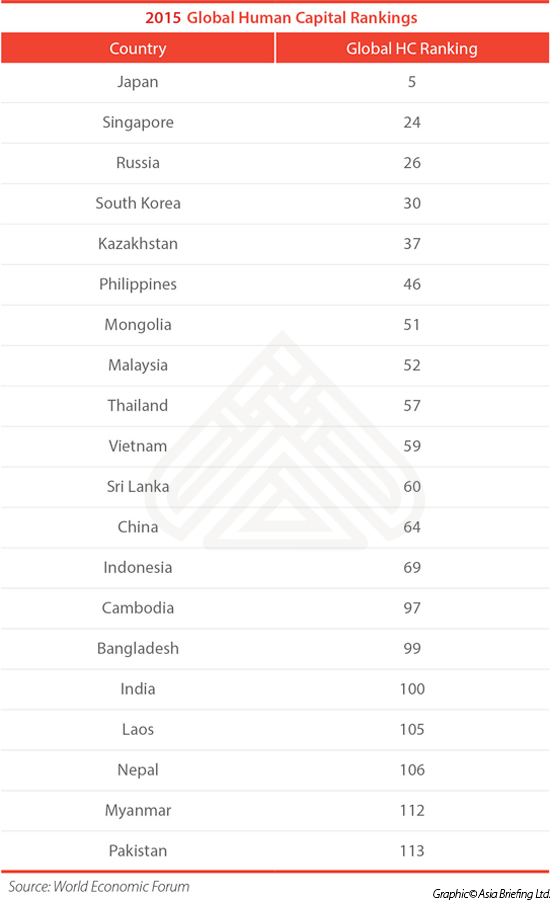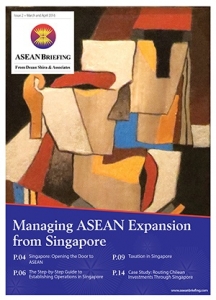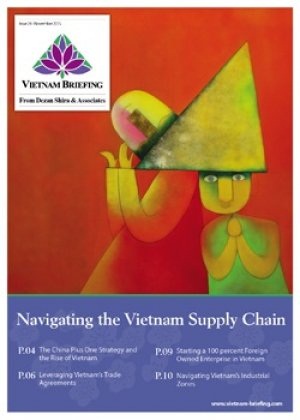China’s Human Capital Capabilities Being Overtaken by ASEAN
The concept of Human Capital, defined as “the skills, knowledge, and experience possessed by an individual or population, viewed in terms of their value or cost to an organization or country,” is an interesting decision making feature that is increasingly entering the corporate foreign investment mindset.
In short, it is an economic value of an employee’s skill set built on the production input of each employee, based on the assumption that all labor is equal. However, the concept of Human Capital also recognizes that not all human labor is equal and quality can be improved by investing in them. The education, abilities and experience of an employee has an economic value for the employer and the national economy as a whole.
Over the years, much has been made of the huge leaps by China in this regard – much of it of course is encouraged by the State itself. China has undoubtedly made massive progress over the last twenty years, however it still, surprisingly, falls short in the actual measurable definitions of Global Human Capital rankings. Below is a list of neighboring and other Asian countries to compare:

It is noticeable that China ranks relatively low at 64, while similar, large populations in countries such as India and Indonesia also rank poorly. That said, the sheer size of a population should not have a negative effect on the rankings, but what it does suggest is that millions of Chinese workers are still not up to speed when it comes to adding value – a rather different scenario that current wisdom suggests.
In fact, China doesn’t feature in the top ten Asian economies leveraging their Human Capital – productivity and the creation of wealth per employee is higher in the ASEAN nations of Malaysia, Philippines, Thailand and Vietnam than it is in China. This should be a cause of concern for Beijing. Higher wages and social welfare costs introduced over the past few years have not resulted in an increase in China’s Human Capital rankings – suggesting paying more for Chinese labor isn’t having an impact on productivity. This can be born out by the complaints many foreign investors are now making – lower margins and slimmer profits amongst an operating environment that is becoming increasingly expensive.
China is also experiencing a slowdown – which becomes problematic as China’s own manufacturing industries are cutting back on costs. This will include employee training and investment – meaning that this in turn impacts upon national productivity. China’s path to upgrade its manufacturing sector and change the economy into a consumer based model may well take rather longer than expected as a result. The country needs to rethink its strategy – imposing higher operating costs on employers in China while keeping the productivity levels the same is not going to work – and will start to drive investors out to other manufacturing hubs.
Over on our Asia Briefing portal, we have already highlighted the 2016 Foreign Investment Opportunities for Malaysia, the Philippines, Thailand and Vietnam. Our Manila, Hanoi and HCMC offices all report an increase in manufacturing facilities being established there by companies relocating from China. Thailand has just announced a huge range of investment incentives, including multi-year corporate income tax breaks and low personal income taxes for foreigners. All now have a higher Human Capital Ranking than China.
A rethink is needed by Beijing to encourage foreign investors to stay. Because increasingly high employment costs matched to a static and low Human Capital ranking do not add up in economic or productivity terms, and businesses have the ability to relocate. An increasingly uncompetitive China is starting to feel some pain. The key is investing in the Chinese workforce, training and improving Chinese skills, and raising the Chinese productivity levels. If that cannot be done, then economic incentives such as income tax breaks need to be re-introduced – or China’s exodus of foreign investors will grow, and FDI will start to bleed out.
|
Chris can be followed on Twitter at @CDE_Asia. Stay up to date with the latest business and investment trends in Asia by subscribing to our complimentary update service featuring news, commentary and regulatory insight.
|
![]()
 Managing ASEAN Expansion from Singapore
Managing ASEAN Expansion from Singapore
For the second issue of our ASEAN Briefing Magazine, we look at the benefits of using Singapore a hub for the management of regional operations throughout ASEAN. We firstly focus on the position of Singapore relative to its competitors, such as the Netherlands and Hong Kong. We then provide step-by-step instructions on corporate establishment, and provide expert insight on maximizing returns through the reduction respective tax burdens.
 An Introduction to Doing Business in ASEAN
An Introduction to Doing Business in ASEAN
An Introduction to Doing Business in ASEAN introduces the fundamentals of investing in the 10-nation ASEAN bloc, concentrating on economics, trade, corporate establishment and taxation. We also include the latest development news in our “Important Updates” section for each country, with the intent to provide an executive assessment of the varying component parts of ASEAN, assessing each member state and providing the most up-to-date economic and demographic data on each. Additional research and commentary on ASEAN’s relationships with China, India and Australia is also provided.
 Navigating the Vietnam Supply Chain
Navigating the Vietnam Supply Chain
In this edition of Vietnam Briefing, we discuss the advantages of the Vietnamese market over its regional competition and highlight where and how to implement successful investment projects. We examine tariff reduction schedules within the ACFTA and TPP, highlight considerations with regard to rules of origin, and outline the benefits of investing in Vietnam’s growing economic zones. Finally, we provide expert insight into the issues surrounding the creation of 100 percent Foreign Owned Enterprise in Vietnam.
- Previous Article Saving Your Labor Costs: Social Insurance Premiums Reduced in China
- Next Article China’s Upcoming 2016 Foreign Investment Law Revisions To Boost Service Sector










